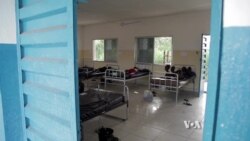Dozens of very sick people sat on the floor in an empty university building in central Sierra Leone.
They waited in filthy conditions.
With the nearest treatment center a 16-hour drive away in Kailahun, there is no way to treat the sick, despite the likelihood they are infected with Ebola.
According to Osman Bah, the Makeni government hospital director, Ebola cases have spiked in recent weeks.
“More than 100, 150 cases, because we have sent 56 patients to Kailahun,” he said. “This morning we have had more than 100-110 patients.”
This university complex is being used as a makeshift holding facility because the sick people have nowhere else to go.
Highly contagious patients lie in the open.
One woman sat on the floor, too sick to stand.
Other victims huddled together on beds.
One young child was laying alone.
They waited and hoped for a space in the next ambulance.
Growing numbers of Ebola outbreak hotspots are emerging in new locations across the country.
“We get phone calls every day from districts over the whole country, and those districts are absolutely overwhelmed,” said Axelle Vandoornick, a medical field coordinator for Doctors Without Borders.
There is no way of telling which patients are Ebola-positive.
Despite this, they are kept together.
“Ninety-nine percent of the cases that we have isolated are positive of Ebola,” said Bah, the medical director.
Medical staff at the containment center have little training or experience dealing with Ebola.
Protective equipment is inadequate.
One makeshift ward was empty.
Beds were filthy.
Pill packets sat among piles of clothes left by a departing patient.
Twenty-five confirmed Ebola patients left for Borders treatment center in Kailahun one recent night.
Four died during the 16-hour journey.
Doctors Without Borders’ Vandoornick said numbers are increasing.
“Every day we have ambulances arriving and when we open the door there are dead bodies inside the ambulance alongside non-cases potentially,” Vandoornick said. “So that is the first source of contamination.”
When two new patients were brought in to the center, one young boy showed symptoms for Ebola.
Despite the risk, his mother would not leave his side.
“It’s too much,” said Karimo Konteh, an ambulance driver. “Every day I pick up 10, 15, 14, 12 patients, everyday. ...”
Vandoornick said some districts have no Ebola treatment facilities of their own.
“They don't have [enough] capacity of Ebola centers in their district, so basically they are trying to send their patients to us,” Vandoornick said.
Bah, the medical director, said he is not hopeful the situation will improve.
“For now the situation is not under control,” he said. “We are hoping it will be better.
“But I am afraid, maybe it will get worse.”











